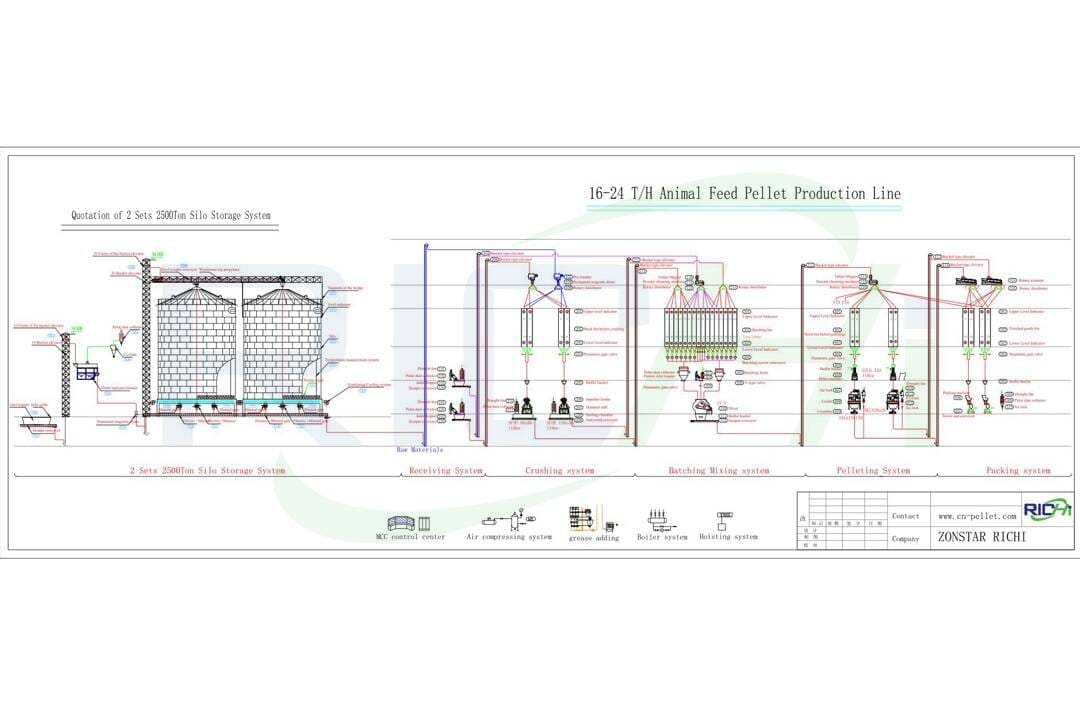The quality of animal feed is the result of the process and equipment, any section or equipment problems, will affect the final particle quality, today to popularize the particle feed processing process quality control.

1. Control of crushing particle size: crush all kinds of feed materials to the particle size most suitable for animal use, so that compound feed products can obtain the best feeding efficiency and economic benefits.In order to achieve this goal, it is necessary to study and master the best utilization granularity of different animal feed materials.For aquatic feed, micro - grinding and micro - grinding technology must be used.
2. Control of dosing accuracy: automatic dosing control technology is adopted so that the dosing amount of each ingredient can be accurately controlled in each batch.The microadditives can be premixed and premixed with a high precision microdosing system.
3. Mixing uniformity control: including mixing uniformity control technology of compound feed, concentrated feed, additive premix feed and liquid feed.Choosing the right mixer and the right mixing time and method is the key to ensure the mixing quality.
4. Pelletizing quality control: firstly, control the quality of the control of feed conditioning, that is, control the temperature, time, water addition and starch gelatinization, so that the state after conditioning is most suitable for pelletizing;The second is to control the hard grain feed powder rate, cooling temperature and moisture, particle uniformity, consistency, water resistance.To achieve these requirements, must be equipped with a reasonable steam supply and control system and conditioning, granulation, cooling, screening equipment, and according to the different requirements of the product scientific adjustment of control parameters.
5. Quality control of expanded pellet feed or expanded feed: firstly, control the temperature-regulating quality of the feed, that is, control the temperature-regulating temperature, time, water addition and gelatinization degree of starch, so that the state after temperature-regulating is most suitable for extruding or expanding;Secondly, the curing degree, density, pulverization rate, cooling temperature and moisture, particle uniformity, consistency and water resistance should be controlled.To achieve these requirements, must be equipped with a reasonable steam supply and control system and conditioning, extrusion, expansion, drying, cooling, screening equipment, and according to the different requirements of the scientific adjustment of control parameters to obtain customer satisfaction.
6. Quality control of liquid additives: with the continuous development of feed processing technology, many additives will be added in the form of liquid powder, granular and expanded feed, and maximize the activity of these additives to reduce the cost of feed.The first is to achieve accurate control of liquid content, the second is to achieve uniform distribution or coating of liquid in the feed, and the third is to ensure the stability and validity of liquid additive after spraying.This requires the use of high performance atmospheric liquid spraying equipment, vacuum spraying equipment and control technology.
7. Control of cross contamination of feed the main places where cross contamination of feed occurs are: leakage and mixing in the storage process;Residues in transport equipment lead to cross-contamination between different products;Cross contamination caused by residues in silos and buffer buckets;Cross-contamination caused by residues in processing equipment;Cross contamination caused by harmful microorganisms, insects, etc.Therefore, it is necessary to use non-residual transportation equipment, silos, processing equipment and correct cleaning, sorting, washing technology and independent production lines to meet the increasingly high requirements for feed safety and hygiene.
8. Quality control of clean and hygienic feed: including control technology of cross-contamination and necessary heat treatment and sterilization technology for feed.Heat treatment includes high temperature cooking, extrusion, high pressure treatment, ultraviolet irradiation and other processes, which can be used in combination with ordinary processing technology, or independently.
If you need to customize your own feed pellet production line, welcome to consult Richi machinery online!


